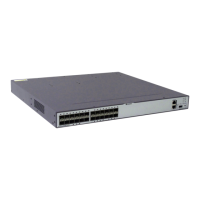Fiber mode Mode of optical fibers defined based on core diameters and features of optical fibers.
Optical fibers are classified into single-mode and multimode fibers. Generally,
multimode fibers have large core diameters and severe dispersion, so they are used to
transmit optical signals over short distances. Single-mode fibers have smaller diameters
and small dispersion, so they can transmit optical signals over long distances.
Modal bandwidth Bandwidth measured at a point with transmit power several dB lower than that of the
point with the peak center wavelength. Modal bandwidth reflects spectrum
characteristics of multimode fibers. The higher modal bandwidth a multimode fiber has,
the longer transmission distance the fiber supports.
Fiber diameter Diameter of the core of a fiber. According to international standards for optical fibers,
the diameter of a multimode fiber is 62.5 um or 50 um, and the diameter of a single-
mode fiber is 9 um. Select optical fibers with diameters supported by the optical modules.
Fiber class Optical signals with different wavelengths have their best working windows in different
optical fibers. To help efficiently adjust wavelengths or dispersion features of optical
fibers and change their refractive indexes, the following fiber classes are defined:
multimode fiber (G.651), common single-mode fiber (G.652), shifted dispersion fiber
(G.653), and non-zero shifted dispersion fiber (G.655). G.651 and G.652 are commonly
used fiber classes. Optical fibers of higher classes support longer transmission distances.
When selecting optical fibers for optical modules, determine the classes of fibers based
on the required transmission distances.
Connector type Type of the interface on an optical module to accommodate a fiber. Commonly used
connector types are LC (applicable to all the SFP, SFP+, and XFP modules), SC, and
MPO (applicable to 150 m QSFP+ and CXP modules). Select optical fibers with
connectors supported the optical modules.
Transmission distance Maximum distance over which optical signals can transmit. Optical signals sent from
different types of sources can transmit over different distances due to negative effects of
optical fibers, such as dispersion and attenuation. When connecting optical interfaces,
select optical modules and fibers based on the maximum signal transmission distance.
Interface rate Maximum rate of electrical signals that an optical component can transmit without bit
errors. The interface rates defined in Ethernet standards include 125 Mbit/s, 1.25 Gbit/
s, 10.3125 Gbit/s, and 41.25 Gbit/s. When connecting optical interfaces, select optical
modules and fibers based on the maximum signal transmission rate.
Center wavelength Wavelength measured at the midpoint of the half-amplitude line in the transmit spectrum.
Two connected optical modules must have the same center wavelength.
MSA Multi-Source Agreement, a non-profit organization jointly established by optical module
manufacturers. This agreement defines the structure and dimensions of optical
transceivers by referring to Optical Internetworking Forum (OIF) and International
Telecommunication Union (ITU) standards.
7.2.4 How to View Optical Module Parameters
S6700 Series Ethernet Switches
Hardware Description
7 Pluggable Modules for Interfaces
Issue 12 (2015-07-31) Huawei Proprietary and Confidential
Copyright © Huawei Technologies Co., Ltd.
91

